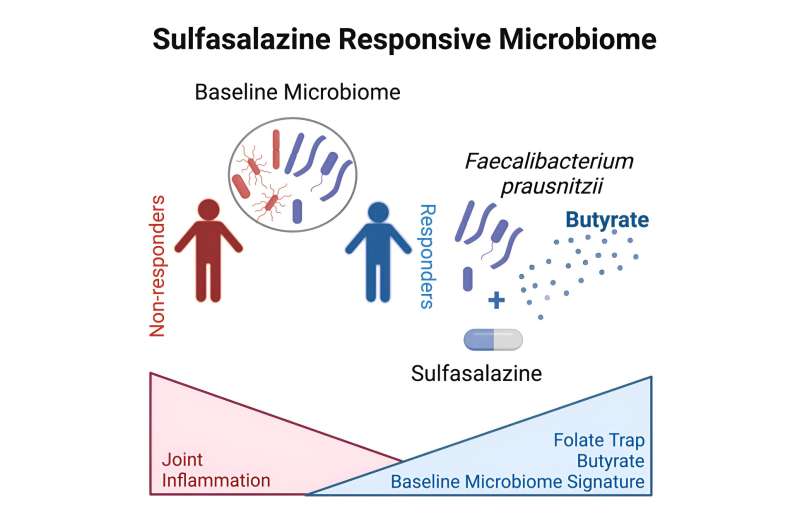This article has been reviewed according to Science X's editorial process and policies. Editors have highlighted the following attributes while ensuring the content's credibility:
fact-checked
trusted source
proofread
New insight into old IBD drug could improve treatments

Although it is one of the oldest medications used to treat patients with inflammatory bowel disease (IBD) and an effective treatment for an associated arthritis condition called spondyloarthritis (SpA), sulfasalazine's mechanism of action has been unclear.
Now, researchers at the Jill Roberts Center for IBD and the Jill Roberts Institute for Research in IBD at Weill Cornell Medicine and NewYork-Presbyterian have determined that the drug works by modulating the activity of a group of gut bacteria that are more abundant in patients whose responded to the drug.
These findings solve a long-standing question of how and why sulfasalazine is effective for some people, but not all, and could lead to advances in treating IBD.
In a study published in Cell Reports Medicine, researchers examined IBD-SpA patients treated with sulfasalazine and found that the presence of the gut bacterium Faecalibacterium prausnitzii was a key factor enabling successful treatment responses. They determined that sulfasalazine works by upregulating this bacterium's production of butyrate, a fatty acid molecule with anti-inflammatory properties.
"These findings offer a way to identify IBD-SpA patients who are likely to respond to sulfasalazine therapy and also suggest new therapeutic approaches," said study senior author Dr. Randy Longman, director of the Jill Roberts Center for IBD and an associate professor of medicine at Weill Cornell Medicine and a gastroenterologist at NewYork-Presbyterian/Weill Cornell Medical Center.
The co-first authors were Svetlana Lima and Silvia Pires, both postdoctoral research associates in the Longman laboratory during the study.
It is estimated that more than 2 million Americans have IBD, which comprises two distinct disorders, ulcerative colitis and Crohn's disease. A variety of treatments are available, but their effectiveness is limited, essentially because scientists don't fully understand the immunological processes that trigger and sustain IBD.
IBD frequently coexists with SpA, and sulfasalazine reduces or eliminates symptoms of both conditions in many of these patients. Prior studies have suggested that it works via the gut microbiome, though the precise mechanism has never been clear.
For the study, Longman and his team evaluated 22 patients with IBD-SpA at the Jill Roberts Center for IBD who were starting sulfasalazine therapy, compared with another 11 who were maintained on standard therapies and used as a control group. About half of the patients treated with sulfasalazine showed clinical improvements by a validated measure of disease severity, whereas fewer than 10% of the control patients improved.
In the sulfasalazine group, the team found that the most striking difference between responders and non-responders was the relative abundance of F. prausnitzii and a group of five gut bacteria in their colons. In a separate group of 16 patients with IBD-SpA, they confirmed that F. prausnitzii and these other bacteria discriminated responders from non-responders.
In further experiments in an animal model of colitis, adding F. prausnitzii to the gastrointestinal tract turned sulfasalazine non-responders into responders.
F. prausnitzii is known as a particularly strong producer of the anti-inflammatory fatty acid butyrate, which has long been linked to gut health. Although butyrate is made by many gut bacteria as a fermentation product of dietary fiber, the team found that sulfasalazine appears to improve symptoms in patients with IBD-SpA by enhancing butyrate production, specifically in F. prausnitzii, not in other butyrate-producing bacteria they tested.
"It is very possible that sulfasalazine's effectiveness in patients with IBD-SpA is limited to specific bacterial species or even strains within species," Longman said.
Confirming butyrate's key role, the team showed that sulfasalazine has no effect in mice when the butyrate receptor on cells—a receptor necessary for butyrate activity—is missing.
The study overall suggests that a clinical test for the presence of key bacteria could someday be used to identify patients who are more likely to benefit from sulfasalazine treatment, Longman said. He added that this approach may be applicable not just to combined IBD-SpA but to either condition separately.
The results also point to the possibility of therapies that would add F. prausnitzii to the gastrointestinal tracts of IBD and SpA patients to boost responsivity to sulfasalazine. Butyrate oral supplements are already popular, and gastroenterologists commonly give butyrate enemas to patients, yet these are only partially effective. Longman suspects that bacteria living in the gut lining are best placed to deliver this beneficial molecule.
He and his team now plan to study in more detail how F. prausnitzii and its sulfasalazine-enhanced butyrate production calm the immunological storm of IBD-SpA.
More information: Svetlana F. Lima et al, The gut microbiome regulates the clinical efficacy of sulfasalazine therapy for IBD-associated spondyloarthritis, Cell Reports Medicine (2024). DOI: 10.1016/j.xcrm.2024.101431




















